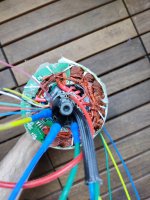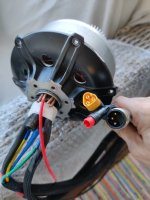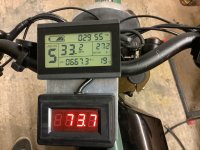abagofcells
1 mW
I have 2 converted MTB's, both have 250 watt rear geared hub motors. Neither of the hub motors have any useful information written on the, except 36v 250w and some numbers that don't give any google results. All I know is they are about the same size as all the other 250 watt motors, commonly seen on EU ebikes.
The first one I built have a locked down controller and 36 volt battery integrated in the rear rack. Measuring the wattage with an external shunt, it would peak at 320 watts on a full battery. I have shunt modded it to peak at 400 watts, and it has run fine like that for a long time, but still speed limited.
My second conversion uses a Kunteng 17a sinewave controller and KT-LCD3, paired with a 48 volt battery. I have a lot more possibilities to tune power levels on this bike, but have so far I have also limited it to peak at 400 watts. This bike is much lighter and agile, and for my commute to work, I can run it at 200 watts, and still maintain 30-35 km/h, only running it at 400 watts for climbing a couple of hills without loosing speed.
On the other end of the spectrum, I have a Sondors fat bike, that peaks at 800 watts on a full battery, while the motor has 350 watts stamped on it. It has run this way for years, but I'm not completely sure if the controller has been replaced before I got it.
But how much power is really safe to put into these, if I still want them to last a long time? What are your experiences? It seems some people run them at ridiculous amount of power, and other add a bit extra, and instantly fry the motor by breaking without cutting motor power, but I have found very little data on longevity with just a modest power increase.
The first one I built have a locked down controller and 36 volt battery integrated in the rear rack. Measuring the wattage with an external shunt, it would peak at 320 watts on a full battery. I have shunt modded it to peak at 400 watts, and it has run fine like that for a long time, but still speed limited.
My second conversion uses a Kunteng 17a sinewave controller and KT-LCD3, paired with a 48 volt battery. I have a lot more possibilities to tune power levels on this bike, but have so far I have also limited it to peak at 400 watts. This bike is much lighter and agile, and for my commute to work, I can run it at 200 watts, and still maintain 30-35 km/h, only running it at 400 watts for climbing a couple of hills without loosing speed.
On the other end of the spectrum, I have a Sondors fat bike, that peaks at 800 watts on a full battery, while the motor has 350 watts stamped on it. It has run this way for years, but I'm not completely sure if the controller has been replaced before I got it.
But how much power is really safe to put into these, if I still want them to last a long time? What are your experiences? It seems some people run them at ridiculous amount of power, and other add a bit extra, and instantly fry the motor by breaking without cutting motor power, but I have found very little data on longevity with just a modest power increase.






